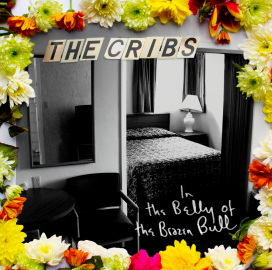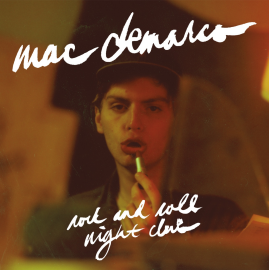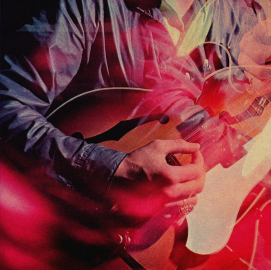Print Edition: May 23, 2012
The Cribs
In the Belly of the Brazen Bull
Despite slogging it out with a series of underwhelming early records as label-groomed understudies to the likes of Franz Ferdinand and The Libertines in the mid-aughts, the Cribs have persevered. Outlasting many of their peers, The Cribs have excelled at making steady improvements to their craft with each subsequent album. In the Belly of the Brazen Bull is the Jarman brothers’ first recorded output since the departure of legendary ex-Smiths guitarist Johnny Marr – who, to the disbelief and insane jealousy of every aspiring musician born in the ‘80s, became a full-fledged member of the group in 2008. The Cribs’ fifth record is a raucous and gleefully sloppy affair full of ‘90s slacker attitude and bravura alt. rock, lightly filtered through the band’s post-2000 major indie British sensibilities. While it lacks the subtleties and dynamic range of last year’s debut record from The Cribs’ compatriots Yuck, faltering in some of the quieter moments, there is something undeniably infectious about the band’s scrappy change of pace. The first five tracks are nearly impeccable, from the Sonic Youth tribute “Jaded Youth” to the more pop-minded “Anna,” but the record is ultimately top-heavy and uneven. Things start to run aground after “Pure O,” suggesting that shaving off a few tracks might have made for a better album overall, but that doesn’t make gems “Glitters Like Gold” and “Chi-Town” any less memorable.
Mac Demarco
Rock and Roll Night Club
AM radio pop music tends to articulate a kind of yearning, a feeling that’s just out of reach, and Vancouver-based Mac Demarco of Makeout Videotape follows closely to this typecast. His harkening back to a bygone era should be credited to Ariel Pink, whose straightforward AM pop has found a niche audience with writing so catchy and warm it’s hard to resist. Demarco’s debut Rock and Roll Night Club contains brittle, jangle guitar hooks and laissez-faire melodies, as Mac baits his audience with his goofy rock ‘n’ roll lyrics and smoky crooner-like voice. The title track and “Baby’s Wearing Blue Jeans” both focus on Demarco’s sleazy baritone voice, which strains like that of a drunken Elvis Presley. There is, however, a surreal and more or less dreamlike 1960s quality to Night Club, creating an atmosphere that sounds almost as if director David Lynch has joined forces with group Real Estate. Night Club is a woozy, glam-infused and sometimes creepy 30 minutes of throwback pop tunes, yet Demarco’s approach evokes genuine blue-eyed soul, meaning there’s more to Mac Demarco than meets the eye.
Best Coast
The Only Place
I don’t know if it’s my deep-seated love for all things California, or because Best Coast is just an amazing band, but the title track off their sophomore album The Only Place picks things up where their debut album left them. Mostly. Notably missing is the lo-fi sound they emerged with, and while that may bring up conflicted feelings, given a few listens, you will finally accept what producer Jon Brion has done. It’s still just as much surf pop, but perhaps it’s now more accessible. Also new here is lead singer Bethany Cosentino’s expanded lyrical base. Interestingly, it is “The Only Place” which is actually the only upbeat song in terms of the lyrics. Of course, every song still comes across with a sound that is hard to take as anything but light summer fun – until you pay attention to the subject. It seems that over the past few years Cosentino has been through some experiences. The three standout tracks here are “How They Want Me to Be,” “Better Girl,” and “Up All Night.” But you know what – they’re all great songs, and it’s an outstanding album.
Chromatics
Kill for Love
Former punk rockers, presently more electronically inclined, Chromatics made a tour of the popular spectrum last year after featuring in the Drive soundtrack, and subsequently seemingly everywhere. Their “Tick of the Clock” has a descendant in Chromatics’ newest album (“Broken Mirrors”), but Kill for Love, a 90-minute electro/magnetic magnum opus, is comprised of lyric and guitar drenched tracks as much as moody midnight beats. Vocalist Ruth Radalet infuses every line with the potency of dreams, echoed by electronic guitar/synth skyscapes that lull and awaken on tracks like “The Page” and “These Streets Will Never Look the Same.” And the penultimate “There’s a Light Out on the Horizon,” has to be in the running for best lyricless breakup song ever. The band recently released an abridged, drumless version of Kill for Love for free, which retains the album’s layered instrumentation, perhaps bringing out more of its subtler sounds due to missing cues and underscores, but it’s only a slice of the whole story. For the intoxicating pleasure of Chromatics is found in their mingling of pop and rock influences and instrumentations, which Kill for Love in its prime version pushes forward as near as possible to its ultimate, fullest extent.






